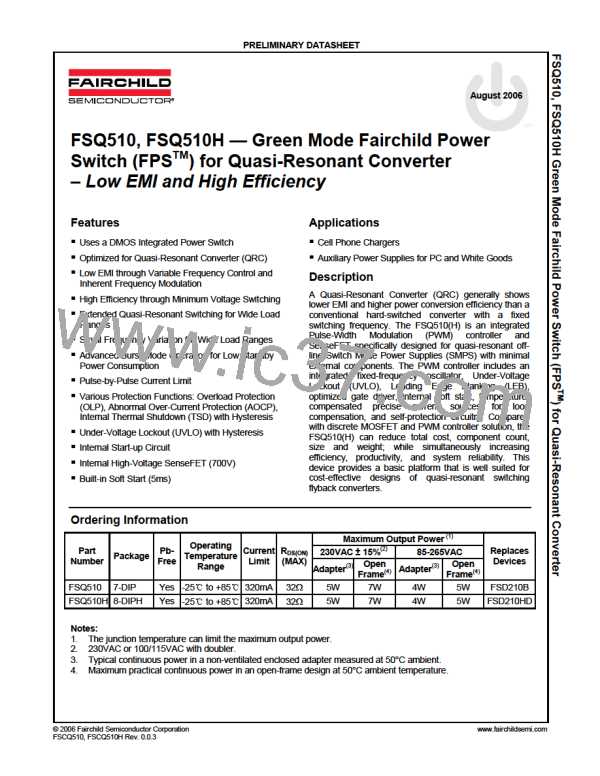PRELIMINARY DATASHEET
4.3 Thermal Shutdown (TSD): The SenseFET and the
Vo
control IC in one package makes it easy for the control
IC to detect the abnormal over temperature of the
SenseFET. If the temperature exceeds approximately
140°C, the thermal shutdown triggers. The FPS stops its
operation at that time. The FPS operates in auto-restart
mode until the temperature decreases to around 80°C.
Then the normal operation of the FPS resumes.
Vose
t
VFB
0.85V
0.75V
5. Soft Start: The FPS has an internal soft-start circuit
that increases PWM comparator inverting input voltage,
together with the SenseFET current, slowly after it starts
up. The typical soft-start time is 5ms. The pulse width to
the power switching device is progressively increased to
Ids
establish
the
correct
working
conditions
for
transformers, inductors, and capacitors. The voltage on
the output capacitors is progressively increased with the
intention of smoothly establishing the required output
voltage. This helps prevent transformer saturation and
reduce stress on the secondary diode during startup.
Vds
time
6. Burst-Mode Operation: To minimize power
dissipation in standby mode, the FPS enters burst-mode
operation. As the load decreases, the feedback voltage
decreases. As shown in Figure 10, the device
automatically enters burst mode when the feedback
voltage drops below VBURL (750mV). At this point,
switching stops and the output voltages start to drop at a
rate dependent on standby current load. This causes the
feedback voltage to rise. Once it passes VBURH (850mV),
switching resumes. The feedback voltage then falls and
the process repeats. Burst-mode operation alternately
enables and disables switching of the power SenseFET,
thereby reducing switching loss in standby mode.
Switching
disabled
Switching
disabled
T
4
T
2
T
3
T
1
Figure 10. Burst-Mode Operation
© 2006 Fairchild Semiconductor Corporation
FSQ510, FSQ510H Rev. 0.0.3
www.fairchildsemi.com
9

 FAIRCHILD [ FAIRCHILD SEMICONDUCTOR ]
FAIRCHILD [ FAIRCHILD SEMICONDUCTOR ]